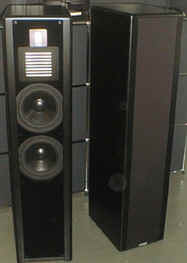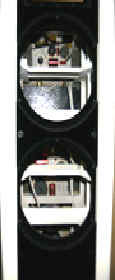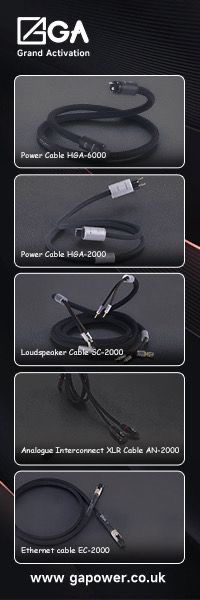The PIEGA P10 (Reference) Loudspeaker
| The PIEGA P10 (Reference) Loudspeaker |
| Ribbons and dynamic drivers: the best of both worlds in one speaker system? |
|
Lew Lanese |
|
30 December 1999 |
Type: 3 Way Floor Standing
Bass: 2 × 8 5/8″ Vifa LDB-Woofers
Midrange: P-1 Ribbon
High Frequency Driver: 2 × LDR/II Ribbon Tweeters
Frequency Range: 22 Hz-50,000 Hz +/- 2dB
Impedance: 4 Ohm
Sensitivity: 89dB/W/m
Recommended Power: 20-300 watts
Weight: 139 lbs.
Size, H/W/D: 47×11×15.8 in
Cabinet Finish: Dim Black or White Varnish;
Optional Extra: Black or White Grand Piano Finish
Manufacturer:
PIEGA SA
Bahnhofstrasse
CH-8810 Horgen/Switzerland
Tel. +41 1-7259042
Fax +41 1-7259192
Distributor:
Pro Audio Ltd.
29111 South Drive
Barrington, IL 690010
Tel 847.526.1646
Fax 847.526.1669
Price: $9,000 Recommended Retail
website: www.piega.ch
“The P10 is glorious music at its best…” –Lewis Lanese
“Oh no, not another speaker system”! Well believe me, this is not just another speaker system! In my humble view, the Piega P10 takes its place among the most rewarding speakers it’s been my pleasure to hear. No, it’s not one of those systems that hits you over the head and says “Listen to me, I’m real hi-fi”. The P10 is glorious music at its best, the kind of speaker that makes you forget about audio, video, demo records, high-end, home-theater, etc., and just sit back and enjoy!
It was unbearably hot in Milan! Anita and I had gone to Italy in September hoping to escape the hot Italian summer but the hot weather hung on. So, it was with a sense of relief that I was on the Cisalpino, one of Italy’s modern fast trains, headed for Switzerland knowing it would be cooler there. The sheer beauty of the Swiss Alps with the small picturesque villages nestled in among the mountains made the 3 ¾ hour trip pass very quickly. The moderate temperature was invigorating.
When he heard I was going to be in Milan, Carlo Struchtrup, Piega’s very affable, friendly Export Manager, invited me to the factory in Horgen, Switzerland. I was already in the midst of reviewing the Piega P10 Reference speaker system. Some of you may remember that I reviewed the P5 for STEREO TIMES six months ago and said “…that I could live quite happily with the Piega P5s; they are that good!” Thus it was with great anticipation that I looked forward to the P10. I was not to be disappointed!
 Piega’s headquarters, located on Lake Zurich, fifteen minutes from the city, is a model production facility presently being enlarged to twice its size.
Piega’s headquarters, located on Lake Zurich, fifteen minutes from the city, is a model production facility presently being enlarged to twice its size.
Although relatively unknown in the United States, Piega SA, founded in 1986 by Leo Greiner and Kurt Scheuch (engineers in the field of electromagnetics), is very successful in Europe supplying a large number of popular high-end and home theater systems. Its products have been highly acclaimed in the European audio press. On the basis of my experience with the P5 and P10, I enthusiastically recommend that you take the opportunity to audition them if one of the few (at present) dealers is convenient to you.
Technical Aspects
Yes, the P10 is big! It is a ported, three-way, floor standing loudspeaker nearly four feet tall, narrow but deep (almost 16″) with a considerable internal volume of 120 liters for the two 8.5″ woofers. But because it’s narrow and deep, it doesn’t appear that large. The special, proprietary Vifa woofers can and do produce substantial, weighty bass when the source demands it. There are two front firing ribbons: a midrange ribbon about four inches square; and a tweeter about 2.5 x 1.5 inches. There is a second rear, firing tweeter that may be covered if your room is already very lively. All of the drivers have been very carefully selected and matched to eliminate the slighted variations. The crossover is fourth order (24 dB per octave) with the crossover points at 500 Hz between the woofers and ribbon midrange, 3.5k Hz between the midrange and tweeter and 7k Hz for the rear firing ribbon tweeter. As I noted in my P5 review:
The connector plate on the rear of the cabinet provides for bi-wiring and sports several switches mostly to adjust for differences in room acoustics. The “Low Level” switch allows you to toggle between “normal” and “extended” response; “extended” provides for flat, low frequency response, “normal” cuts frequencies below 40 Hz where low frequency distortion such as turntable rumble might be a problem. The “High Level” switch has three positions “N, -, +”; “N” is for flat response, “-” represents a 2 dB cut from 5k Hz to 18k Hz, “+” represents a 2 dB increase from 5k Hz to 18k Hz. All my listening was done with the switches set at “extended” and “N”.
During my visit to Piega’s production facilities I was able to view the procedure for manufacturing their unique and proprietary ribbons (pleated to create rather stiff membranes that don’t change impedances with frequency – similar to a conventional cone driver). As you can see in the photographs, with both the midrange and tweeter a jig is used to press, stretch and assemble the driver:
|
|
|
|
|
|
“I detected no obvious cabinet vibrations/colorations in the many hours of listening.”
The cabinet panels are double thick MDF, nearly two inches! Bituminous plates cover all interior surfaces of the cabinet. The tweeters are sealed in the rear while the midrange ribbons have their own separate sealed compartment. The remaining internal volume (devoted to the woofers) is constructed with a matrix similar to the B&W and filled with polyester wool. It is no surprise that the weight of each speaker is 139 lbs. How successful is this elaborate design and fabrication? I detected no obvious cabinet vibrations/colorations in the many hours of listening!
In the illustration you can see part of the matrix, the crossovers and some of the bituminous plates.
Setting Up The System
The Piega provides for bi-wiring or bi-amping; I bi-wired them to my VT 8000 MK monoblocks. You also have the alternative of strapping (provided) the speaker connections and using a single speaker cable. It is always a bit painful going through the “break-in” period for a new piece of equipment and it was no exception with the P10s. Now and again I sneaked a listen but it was a good two to three weeks before I began to seriously listen to the Piegas.
Initially I set up the speakers in what is usually typical in my living room; nine feet from the rear wall, 52 inches from the side walls and toed in toward my listening position. When serious listening begins I then make adjustments for imaging, focus and depth keeping in mind the balanced response of the system. All of this is dictated by the dimensions and liveliness of the room which is 15’ wide by 25’ long, with a cathedral ceiling; at the apex it is 9’ high and 5’10″ at either end. Fortunately Bill Brassington happened over when I was working on placement: when it comes to ideally positioning the speakers Bill is the guru. (Final placement must wait until the speakers are broken-in.) We ended up moving the speakers about 36 inches from the side walls and toeing them in more acutely. With the P5 I had to augment the low bass with a subwoofer since it was so far from the rear wall. That was not necessary with the P10.
Since the Bidat D/A converter has its own wired, remote gain control, initially the CD source was connected directly to the amplifiers. But most of my listening was through the preamp that provided more realistic dynamics.
Sound Experiences
“…air, openness and detail I have not quite experienced with any other speaker.”
Piega has attempted to make a serious and significant statement in the creation of their reference P10. There is major competition in the $8,000 to $12,000 price class – B&W, Dynaudio and Von Schweikert (his new speakers will be shown at CES 2000) to name but three. True, there are many excellent speakers from which to choose. And true, each is different than the others; different, and sometimes unique, in the design and execution, and different in the way each behaves synergistically in a specific system and certainly in the way each behaves in a particular acoustic environment.
The P10 is unique in the proprietary design and application of its ribbon drivers. Piega have gone all out to hand-pick and match each item from among the components that go into the manufacture of the speaker (you could probably say as much for the Dynaudio Confidence 5, the Von Schweikert VR6 as well as the B&W 801 or 802). But have they succeeded in reaching their objective? My answer is a resounding yes!
The Piega’s were nine feet from the rear wall yet there was no lack of low bass. The interior matrix construction, double-thickness MDF, bituminous panels on the inner walls and polyester wool filler all contribute to the virtual elimination of any cabinet coloration.
There was a measure of air, openness and detail I have not quite experienced with any other speaker – not a fatiguing “hi-fi” kind of sound but relaxed with refinement and control and altogether true to the music. I attribute this to the ribbon drivers that operate from 500 Hz to far beyond my hearing. But I was never aware of the ribbons i.e. they never highlighted themselves, so faultless and natural were they. Whether I was playing CDs or LPs, the Piegas were consistent in their reproduction.
The recording of “the name is Makowicz”, Adam Makowicz on piano, Phil Woods on saxophone, with Marc Johnson, Phil Goodwin and Gene Estes (Sheffield Lab 21) is a “Direct-to-Disc” LP release that is surely out-of-print (it may be available on CD). You might feel it is unfair to highlight an OP disc but there are some outstanding examples of superbly recorded percussion, drums and piano on this jazz record. The cymbals as reproduced on the Piegas have a live quality that I have never before quite heard with any other speaker.
Piano, drums and percussion on this recording will expose anything less than superb transients in a system. The extraordinary response of the midrange and tweeter ribbons together with the speed of the two Vifa 8 ½ inch bass drivers were more than up to the demands of the record. The Sheffield record, as well as several others in my collection, as my listening notes indicate, demonstrate a coherence, neutrality and lack of coloration matched by very few speakers in my experience. Air and openness, transparent yet sweet, a solidity in the bass together with outstanding dynamics are the hallmarks of the Piega P10.
There was an effortless quality in the reproduction that contributed to hours of listening without any sign of fatigue. The speakers were always involving, delivering impact and invariably, tonally correct. Whether I was listening to jazz, classical, opera, popular or rock, the speakers rendered what the recording required.
I measured the frequency response with the Gold Line Real Time Analyzer setting the microphone at my listening position and using pink noise from a CD test record. The graphic results displayed what in fact my ears had told me. The response was generally flat, not varying more than +/- 5dB. At 25 Hz , response was down only –3dB. Those, of course, were the results within the acoustical environment of my living room.
Conclusion
Piega is a Swiss speaker manufacturer whose products have recently been introduced into the United States. The most recent Audio Directory lists far more speaker systems than any other single audio category. The high-end market, particularly for new speakers, is very competitive and certainly at a time when computers and home-theater are having such an impact on audio. However, the P10 is a serious entry into the loudspeaker market. It is a system that is coherent, balanced, tonally accurate, detailed and open, with dynamic impact, clean transients, good imaging and depth; a system that is effortless in its reproduction of music that will reward you with many hours of listening without fatigue. Perhaps the most impressive thing about this speaker is that you can play it at ear shattering levels without the speakers compressing the sound or becoming raucous or rift with distortion! It is simply louder! Alternatively, at low levels they maintain all of their most positive qualities without losing dynamics – a most impressive aspect of a top notch system!
If you are an audiophile or music lover who has always loved the special sound of electrostatics, ribbons and similar speaker systems but despair at the lack of dynamics, low bass or unacceptable union with dynamic woofers in hybrid versions, then take heart, the P10 has solved the problem! No, it is not a ribbon dipole but these unique ribbon drivers have the best of what is so coveted with this technology and they are married to fast proprietary woofers with excellent lows, midbass and dynamics. On the other hand, dear reader, if you are simply turned on by full range speakers that have all the qualities of an excellent speaker system, whatever the design, and without the necessity for subwoofers and the like, then I urge you to take the opportunity of hearing the Piega P10. I have yet to hear a speaker in this price class that betters the P10. The Piega P10 is now my reference speaker and I expect it to be for a long time to come!
To answer the question posed at the beginning of this review, yes,this is the best of both worlds!
P.S. After the completion of this review, I added the Sony SCD-1, Super Audio CD player to my equipment. The Piega took full advantage of this wide band 20 Hz – 50K Hz (100K Hz in the Custom setting) system, demonstrating the immense superiority of DSD over conventional CDs. (See Clement Perry’s full review and my initial impressions of the SCD-1)
If you expect to be at CES 2000 in January you will find Piega exhibiting there. Sometime later in the year 2000, Piega will release a “cost-no-object” speaker system.
![]()
Stereo Times Masthead
Publisher/Founder
Clement Perry
Editor
Dave Thomas
Senior Editors
Frank Alles, Mike Girardi, Russell Lichter, Terry London, Moreno Mitchell, Paul Szabady, Bill Wells, Mike Wright, and Stephen Yan,
Current Contributors
David Abramson, Tim Barrall, Dave Allison, Ron Cook, Lewis Dardick, John Hoffman, Dan Secula, Don Shaulis, Greg Simmons, Eric Teh, Greg Voth, Richard Willie, Ed Van Winkle, Rob Dockery, Richard Doron, and Daveed Turek
Site Management Clement Perry
Ad Designer: Martin Perry


 Specifications
Specifications





Be the first to comment on: The PIEGA P10 (Reference) Loudspeaker